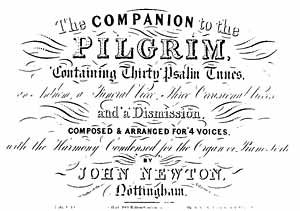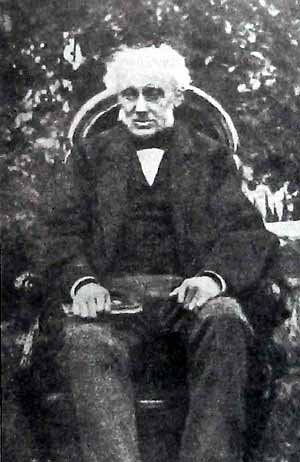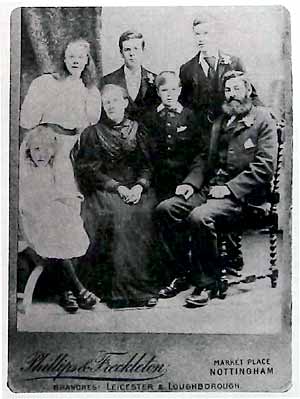< Previous
A TALENT FOR HARMONY:
John Newton of Sneinton
By Stephen Best
For a considerable part of the nineteenth century there lived in Sneinton a man who never had much in the way of material possessions, but who was to leave behind him a notable reputation as a composer of hymn tunes. As we shall eventually see, he also left behind him a descendant whose name was to give rise to many conflicting emotions.
 TITLE PAGE OF JOHN NEWTON'S 'COMPANION TO THE PILGRIM', published in 1839 by J. Hart of Hatton Garden, London.
TITLE PAGE OF JOHN NEWTON'S 'COMPANION TO THE PILGRIM', published in 1839 by J. Hart of Hatton Garden, London.John Newton was born in January 1802 in Rice’s Place (now Riste’s Place) off Barker Gate. His parents attended Castle Gate Congregational Church, and John, as a boy, accompanied them. He was very soon set to work in the lace trade, in which he remained a twisthand all his working life. At the age of twenty-two John Newton married, afterwards becoming a worshipper at the Zion Chapel on the corner of Fletcher Gate and Bottle Lane, where the services were conducted by the Rev. J. Jacks of New Sneinton. At Zion Chapel John Newton's self-taught musical skill came to the fore, and he was given charge of the choir and made generally responsible for the musical content of services. About 1830 a slump in the lace trade obliged John Newton to look elsewhere for work and he moved, with his family, the few miles to Beeston. Here he was busy setting up a choir for the newly-built Wesleyan Chapel and taking charge of the music sung and played during the services. During his time at Beeston, Newton composed many new tunes for hymns then in general use. It was said of him that he was always willing to lend the manuscripts of his tunes, and that before long others were putting his compositions into print. In 1833, therefore, John Newton resolved to bring out a volume of music himself, but to make this possible he had to secure subscribers willing to pay for copies before publication. To this end he trudged from village to village, giving small concerts, and about the end of 1834 was able to publish his first collection of hymn tunes, calling it 'The Pilgrim' as a reminder of the many journeys he had had to make before the book became a reality. 'The Pilgrim' contained 28 tunes with ringing titles like 'Israel's Shepherd' and 'Tuneful Trumpet', and included John Newton's setting of Samuel Davies’s hymn 'Great God of wonders!' to his tune 'Sovereignty'. This was to be, perhaps, his most enduring composition, and was to appear in the Methodist Hymn Book of 1904. Although most of the subscribers to 'The Pilgrim' lived in Nottingham, Newton managed to attract patrons from as far away as Sheffield, Lincoln and Leicester. 1834 saw a further upturn in John Newton's fortunes, since the lace trade recovered sufficiently for him to return to Nottingham. Here he began a fruitful period as choirmaster at Parliament Street Methodist Chapel, a post he held for about eight years. At this time he was writing prolifically, publishing in 1839 'A Companion to the Pilgrim, containing tion of hymn tunes, calling it 'The Pilgrim' as a reminder of the many journeys he had had to make before the book became a reality. 'The Pilgrim' contained 28 tunes with ringing titles like 'Israel's Shepherd' and 'Tuneful Trumpet', and included John Newton's setting of Samuel Davies’s hymn 'Great God of wonders!' to his tune 'Sovereignty'. This was to be, perhaps, his most enduring composition, and was to appear in the Methodist Hymn Book of 1904. Although most of the thirty psalm-tunes, an anthem, a funeral piece, three occasional pieces and a dismission.' For this volume Newton was able to attract 271 subscribers, including seventeen in Sneinton, and he was no doubt very pleased that the choir of Sneinton Parish Church ordered a copy. At Parliament Street Chapel he devised special musical services for the great festivals of the year. One of these was, astonishingly, a service at six in the morning on Christmas Day, with full musical trimmings, including a choir and orchestra. Evidently musicians and congregations alike were made of stern stuff in those days, it being recalled years afterwards that those who came once, came again, as long as the service continued'.
The 1841 census recorded the Newton household in Haywood Street, off Sneinton Road. At that date John and his wife Eleanor had a family of seven, ranging in age from 13 year old Lettice to the baby Eleanor, just three months old. During the 1840s John Newton's musical life developed further; he began to write oratorios, and music for church anthems. About 1845 'A Third Volume of sacred music' was published, followed a few years later by the last of Newton's collections, 'A Fourth Set of tunes, anthems and pieces'. About this time, too, his work began to be performed widely in public, and it is related that audiences of approaching two thousand would attend the Mechanics’ Hall to see the Sneinton lace maker conduct the assembled local orchestras and choirs.
It has already been remarked that Newton was a self-made musician, and certainly he was a versatile one; composer, conductor, choirmaster and performer on the piano, organ and flute. It is doubtful whether he could ever have afforded music lessons, and one can only wonder how a man who fathered nine children found the time to fit in his musical composition and church work with the demands of family life and the long, ill-paid hours of work as a twisthand. John Newton was, however, fortunate in his employer. He worked for many years for the firm of Cope and Ward, whose premises were for a time in Broad Marsh, and later at New Basford. The owner of this business was William Cope of Hempshill Hall, who according to the local press 'took a friendly interest' in Newton’s musical progress. Whether Mr. Cope bought a piano for John Newton will never be known, but one of the composer's great grandsons was to recall as recently as 1950 that the old gentleman 'was always at the piano' whenever he was at home.
When the Albion Chapel opened in 1856, the Newtons went to services there for a time, before becoming regular attenders at the Wesleyan Mission Room in Eldon Street. With the establishing of the Baptist Tabernacle at the corner of Melbourne Street and Peachey Street, John Newton changed his place of worship once more becoming 'a conspicuous figure on the platform' there. (Many readers will remember the Tabernacle better as the Regent Hall on Mansfield Road.) Newton was the possessor of a simple faith, accepting his musical talent as a gift of God, and grateful that he had been able to put this skill to work in the church rather than in the pub.
 JOHN NEWTON AT THE AGE OF 83.
JOHN NEWTON AT THE AGE OF 83.Over the years the household at Haywood Street was getting smaller. During the 1840s Lydia, the second eldest daughter, had left home to get married. Later, another of the Newton children, Ann, became the wife of a prominent Sneinton resident. This was William Straw of Notintone Place, accountant, house agent, tax collector, and a pillar of the Albion Chapel. By 1871 only three of the family were living at Haywood Street; John Newton, now a widower, shared the house with his two unmarried daughters Lettice and Eleanor, both lace workers. Although he was never well off, Newton was not without friends in his old age. A group of well-wishers, including Samuel Peach, a lace manufacturer of Castle Gate and fellow-worshipper at the Tabernacle, did what they could for him, and, in the words of the Nottingham Daily Express, 'a small fund was provided, which was of great use to the old man, whose last days were cheered by the knowledge that he was not entirely forgotten in his native town'. A photograph of John Newton in his 84th year shows a balding, white-haired old gentleman with side whiskers, seated, formally clad, in a chair. Though his expression suggests that he was not at ease before the camera, his face is, one thinks, a kindly one. The year 1886 found him still composing, despite being afflicted with palsy, and only a fortnight before his death he completed a Te Deum. On July 4th John Newton died, not in Sneinton, but not far away, at 5 Rathbone Place, off Middle Hill, which ran up from Broad Marsh to Weekday Cross. The cause of death was stated to be old age and paralysis, and the informant was his daughter Lettice Newton who, despite all her father's accomplishments, could only make her mark, rather than sign the document. The Nottingham Evening Post of July 5th contained a brief story under the headline 'Death of a Nottingham composer'. It described John Newton as 'A Nottingham man, who, although occupying humble social station, was not without fame as a composer of sacred music'. Newton's funeral at the General Cemetery was attended 'by two or three hundred of his old friends and acquaintances'. The service was conducted by the Rev. H.E. Stone, Minister at the Tabernacle, and among the hymns sung were two with tunes by John Newton, 'Sovereignty' and 'Admiration'. Samuel Peach was among the mourners, together with James Wright Adcock, another lace manufacturer and an admirer of Newton's music. In its report of the funeral the Nottingham Daily Express said of John Newton that he 'was in every respect a self-made man. His knowledge of musical matters generally was considerable, and he had a talent for harmony which was very marked. He was lately in poor health, but this was not to be wondered at, seeing that he had reached the advanced age of 85'.
Almost a quarter of a century after his death, interest in John Newton was lively enough for an article about him to appear in the March 1910 issue of a periodical called 'The Choir'. Most of the research was carried out by John Rogers of Tennyson Street, Nottingham, an octogenarian hymnologist, collector of Bibles, and supporter of the Sunday School movement. Mr. Rogers was diligent in tracing details of Newton's life and works, and the present writer acknowledges his debt to that research. Some five years later one or two reminiscences of John Newton appeared in the Nottingham Guardian. One correspondent, writing from Philadelphia in the United States, recalled that Newton's 'Sovereignty' had been often played by the Salvation Army, and had been one of Bendigo's favourites at his Sunday evening revivalist meetings. Another contributor, William Lewin of Nottingham, assessed the quality and style of John Newton’s music. In his view the best piece was 'Hark! a voice divides the sky', a funeral anthem with, like much of Newton's work, traces of Handel's influence.
Mr. Lewin considered that the great tune 'Sovereignty' was really a hymn-anthem for band accompaniment. By 1915 it was sung only rarely, and he put this down to the fact that few choirs could do it justice, the bass part apparently being difficult.
Little mention of John Newton has appeared in print over the years, and if the name crops up in connection with hymns nowadays, a different John Newton is likely to be under discussion. This was the 18th century slave-trader who became a Church of England clergyman and wrote the hymn 'Amazing Grace'. It is hoped, though, that readers of Sneinton Magazine will feel that John Newton of Haywood Street deserves better than the virtual oblivion to which he has been consigned.
 THE LAWRENCE FAMILY IN THE 1890s.
THE LAWRENCE FAMILY IN THE 1890s.The young David Herbert Lawrence stands between his mother and father.
It has already been hinted that Newton had a descendant of some celebrity. It is safe to assume that among the 'two or three hundred' present at his funeral on July 6th, 1886 were some members of his family. One of his great-grandchildren, though, was less than ten months old, so was perhaps more likely to have been at home some eight miles away, in Eastwood. His name was David Herbert Lawrence. This is an article about John Newton rather than D.H. Lawrence but some brief explanation of their kinship seems called for. In 1841 Lydia Newton was eleven, and living at home with the rest of the family, but on Boxing Day 1847 she was married at St. Stephen's Church, Sneinton, to 'George Beardsall, full age, bachelor' of Queen Street (now Pennyfoot Street). The registers described her as 'Lydia Newton, minor, spinster' of Henry Street. Perhaps Lydia, who must have been 18 or 19 at the time of her marriage, had moved round the corner to Henry Street to ease the cramped conditions which must have prevailed at Haywood Street. Her father appears in the register as 'John Newton, twisthand'. George Beardsall, then in his early twenties, was to be remembered as a quarrelsome man and a religious zealot; he became a prominent Wesleyan preacher, said to have been involved in disputes with such future celebrities as William Booth and Jesse Boot. In view of their Nonconformist backgrounds it is mildly surprising to find that George and Lydia were married at the parish church, but this was to happen again within the family. George Beardsall's work as a 'mechanic' took him and Lydia away from Nottingham, where he had worked for a bobbin and carriage maker. Their three elder children, Lydia, Ellen and Lettice were born in Manchester, before George obtained work at Sheerness Dockyard, where he became an engineering foreman. Three more children were born there, before the family's return to Nottingham. The 1871 census return showed that the Beardsall family was then living in John Street (later Keswick Street) Sneinton. George (incorrectly listed as John) Beardsall was shown as a 46 year old 'engine fitter (superannuated)', while his wife Lydia was 42. Their eldest daughter, also Lydia, was nineteen, while Herbert, the youngest of the Beardsalls, was less than a month old. Lydia Beardsall had been born in July 1852, and during the family’s stay in Sheerness, had worked for a time as a teacher. It must have been a sad comedown for her on her arrival in Sneinton to have to earn a living as a lace drawer, the occupation she was following in 1871.
Lydia met Arthur Lawrence in 1874, while he was in Nottingham, and working at Clifton Colliery. Lawrences's home was at Brinsley, where his father was a tailor. The couple met at the Basford home of Lydia Beardsall's uncle John Newton and his wife Alice, who was the sister of Arthur Lawrence's mother. Arthur and Lydia were thus tenuously related by marriage before they ever met. Perhaps theirs was an attraction of opposites - the rough, vigorous coal miner and the ladylike ex-schoolteacher. Their courtship cannot have been an unduly protracted one, since on December 27th, 1875, 28 years and a day after her mother’s wedding, Lydia Beardsall married Arthur John Lawrence at Sneinton Parish Church. His occupation was given as 'mining contractor', perhaps a sign that he was anxious to advance his social status in the eyes of the world. After living at Sutton-in-Ashfield and Radford the Lawrences settled in Eastwood, where, on September 11th, 1885 their third son and fourth child David Herbert, young Bert, was born. Millions of words have been written about D.H. Lawrence, and no doubt thousands more will appear in this, his centenary year. Suffice it here to point out that without John Newton, twisthand and hymn tune composer of Sneinton, the course of English literature would have been different, and hundreds of literary critics would have been obliged to find another author to write about.
Photographs, COURTESY OF NOTTINGHAMSHIRE COUNTY LIBRARY, LOCAL STUDIES LIBRARY.
< Previous
